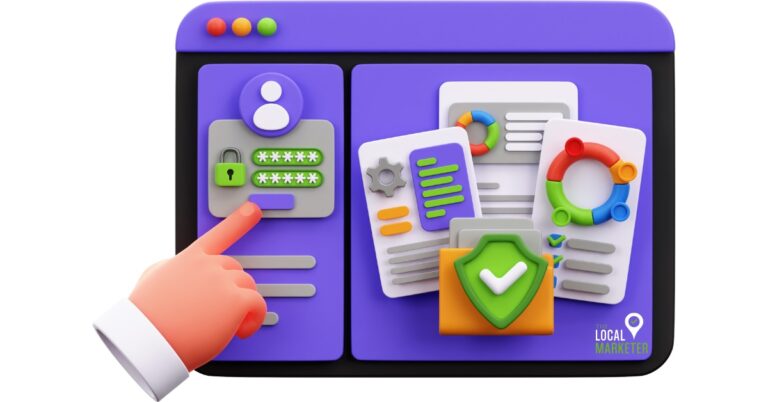Get Noticed: 6 Foolproof Steps to Promoting Your Small Business
Starting a small business is just the first step in a long journey. Success doesn’t come overnight. It takes strategic promotion and consistent effort. But how exactly do you promote your business to get it noticed? This post will break down six easy, foolproof steps to help your small business stand out in a crowded market. No matter the industry, these tips will give you a leg up on the competition. So let’s dive in and learn how you can make your small business shine.
Step 1: Research Your Target Market, Identify Your Ideal Customer
To effectively promote your small business, it’s essential to first research your target market and identify your ideal customer. This step lays the foundation for all your marketing efforts, allowing you to tailor your messaging and strategies to resonate with the right audience.
Understand Your Target Market
Before you can identify your ideal customer, you need to have a clear understanding of your target market as a whole. Start by gathering information about the demographics, psychographics, and behaviors of your potential customers. Consider factors such as age, gender, location, income level, interests, and buying habits.
Conducting market research, using tools like surveys, focus groups, or analyzing online data, can provide valuable insights into your target market. By understanding their needs, preferences, and pain points, you can create marketing campaigns that address their specific challenges and desires.
Define Your Ideal Customer
Once you have a broader understanding of your target market, it’s time to identify your ideal customer. This individual represents the most profitable segment of your target market and is most likely to engage with your business and make a purchase.
To define your ideal customer, create a buyer persona. This is a fictional representation of your ideal customer, based on real data and insights. Consider their demographics, interests, motivations, goals, and challenges. Paint a detailed picture of who they are, what they value, and how your product or service can meet their needs.
Tailor Your Marketing Strategies
By researching your target market and defining your ideal customer, you can now tailor your marketing strategies to effectively reach and engage with them. Here are a few tips to get you started:
- Craft compelling messaging: Use the language, tone, and style that resonates with your ideal customer. Highlight the benefits of your product or service, addressing their pain points and offering solutions.
- Choose the right channels: Based on your target market’s preferences and behaviors, select the most effective marketing channels to reach them. This could include social media platforms, email marketing, content marketing, or traditional advertising.
- Personalize your approach: Use personalization techniques to make your marketing efforts more relevant and engaging. Address your ideal customer by name, tailor your offers to their specific needs, and create personalized content.
- Monitor and analyze: Continuously monitor the performance of your marketing campaigns and analyze the data. This will help you refine your strategies, optimize your efforts, and ensure you are effectively reaching your target market.
Remember, understanding your target market and identifying your ideal customer is an ongoing process. As your business evolves and market trends change, it’s crucial to stay updated and adapt your strategies accordingly.
By investing time and effort into researching your target market and identifying your ideal customer, you can create marketing campaigns that truly resonate with your audience, increasing your chances of getting noticed and promoting your small business successfully.
Step 2: Choose a User-Friendly Website Platform and Optimize Your Website for Search Engines
When it comes to promoting your small business, having a user-friendly website platform and optimizing it for search engines is crucial. In this section, we will explore the importance of choosing the right website platform and how to optimize your website for better search engine visibility.
Choose a User-Friendly Website Platform
Selecting a user-friendly website platform is essential to ensure a smooth and enjoyable experience for your visitors. Here are a few key considerations when choosing a platform:
- Ease of Use: Look for a platform that is intuitive and easy to navigate. This will make it simpler to create and update your website without requiring extensive technical knowledge.
- Mobile Responsiveness: With the increasing use of mobile devices, it is crucial that your website is mobile-friendly. Choose a platform that offers responsive design, ensuring your site looks great and functions well on all devices.
- Customization Options: A good website platform like WordPress, should offer a range of customization options to reflect your brand and business needs. Look for templates and themes that can be easily customized to match your desired look and feel. We recommend SeedProd.
- Integration Capabilities: Consider the integration capabilities of the platform with other tools and software you may be using, such as customer relationship management (CRM) systems or email marketing platforms. Seamless integration can streamline your business operations.
By carefully evaluating these factors, you can choose a user-friendly website platform that meets your requirements and enhances the overall user experience.
Optimize Your Website for Search Engines
Once you have selected the right website platform, it’s time to optimize your website for search engines. This is crucial for improving your online visibility and attracting organic traffic. Here are some key steps to follow:
- Keyword Research: Start by conducting keyword research to identify the terms and phrases your target audience is using to search for businesses like yours. Use keyword research tools to find relevant keywords with high search volumes and low competition.
- On-Page Optimization: Optimize your website by incorporating the selected keywords into your page titles, headings, meta descriptions, and content. Ensure that your content is well-structured, easy to read, and provides value to your visitors.
- URL Structure: Use descriptive and keyword-rich URLs for your website pages. This will help search engines understand the content of your pages and improve your chances of ranking higher in search results.
- Site Speed: Improve your website’s loading speed by optimizing image sizes, minimizing code, and leveraging caching techniques. A fast-loading website not only improves user experience but also positively impacts search engine rankings.
- Mobile Optimization: As mentioned earlier, ensure your website is optimized for mobile devices. With the increasing use of smartphones, search engines prioritize mobile-friendly websites in their rankings.
- Link Building: Build high-quality backlinks to your website from reputable sources. This can be achieved through guest blogging, content marketing, and reaching out to industry influencers. Quality backlinks signal to search engines that your website is trustworthy and authoritative.
By implementing these optimization strategies, you will increase your chances of ranking higher in search engine results and attract more organic traffic to your website.
Remember, choosing a user-friendly website platform and optimizing it for search engines are essential steps to get your small business noticed online. Invest the time and effort into these areas, and you’ll be well on your way to building a strong online presence for your business.
Step 3: Identify Relevant Social Media Platforms, Create Engaging and Shareable Content
In today’s digital age, social media has become a powerful tool for promoting businesses, both big and small. By identifying the most relevant social media platforms for your small business, you can effectively reach and engage with your target audience. Additionally, creating engaging and shareable content is crucial to capturing the attention of your followers and expanding your online presence. Let’s explore these two important steps in more detail.
Identify Relevant Social Media Platforms
When it comes to social media, not all platforms are created equal. It’s essential to identify the platforms that are most relevant to your small business, as this will allow you to focus your efforts and resources effectively. Here are a few tips to help you make the right choices:
- Know your target audience: Understand the demographics, interests, and online behaviors of your target audience. This knowledge will guide you in selecting the social media platforms that align with their preferences.
- Research popular platforms: Conduct thorough research to identify the social media platforms that are most widely used by your target audience. Consider factors such as user engagement, industry relevance, and advertising opportunities.
- Consider platform strengths: Each social media platform has its own unique strengths and features. For example, Instagram is visually-driven and ideal for businesses in the fashion, food, or travel industries. LinkedIn, on the other hand, caters to professionals and is suitable for B2B businesses. Evaluate these strengths and choose platforms that align with your business goals.
- Analyze competitor presence: Take note of which social media platforms your competitors are utilizing successfully. While you shouldn’t blindly follow their lead, it can provide valuable insights into which platforms may be worth exploring for your own business.
Once you have identified the most relevant social media platforms, it’s time to focus on creating engaging and shareable content.
Create Engaging and Shareable Content
Creating content that captures the attention of your audience and encourages them to share it with others is a surefire way to generate buzz for your small business. Here are some tips to help you create engaging and shareable content:
- Be customer-centric: Your content should revolve around your customers’ needs, interests, and pain points. Address their problems, offer solutions, and provide valuable insights. By doing so, you establish yourself as a trusted source of information and increase the likelihood of your content being shared.
- Use compelling visuals: Humans are visual creatures, so incorporating eye-catching images, videos, and infographics into your content can significantly enhance its appeal. Visual content is more likely to be shared and can help convey your message more effectively.
- Tell stories: Storytelling is a powerful tool for engaging your audience. Craft narratives that resonate with your target audience and evoke emotions. Whether it’s through personal anecdotes, case studies, or testimonials, storytelling helps create a connection and encourages sharing.
- Keep it concise and scannable: In today’s fast-paced world, people have limited attention spans. Break your content into easily digestible chunks, use subheadings to guide readers, and incorporate bullet points or numbered lists to convey information quickly.
- Encourage interaction: Prompt your audience to engage with your content by asking questions, encouraging comments, or hosting contests and giveaways. Interactions not only boost engagement but also increase the likelihood of your content being shared.
Remember, creating engaging and shareable content takes time and effort. Continuously monitor the performance of your content and adapt your strategies based on what resonates with your audience.
By identifying the most relevant social media platforms and creating engaging and shareable content, you can effectively promote your small business and get noticed by your target audience. Stay tuned for the next steps in our foolproof guide to promoting your small business.
Step 4: Build an Email List, Create Compelling Email Campaigns
In today’s digital age, email marketing remains one of the most effective ways to reach and engage with your target audience. Building an email list and creating compelling email campaigns can help you stay connected with your customers, drive traffic to your website, and ultimately promote your small business. Follow these foolproof steps to make the most out of your email marketing efforts.
Build an Email List
Before you can start sending out engaging email campaigns, you need to build a solid email list. Here are some effective strategies to grow your subscriber base:
- Offer valuable incentives: Provide exclusive discounts, free resources, or useful content in exchange for email sign-ups. This will entice potential customers to join your list.
- Optimize your website: Place prominent sign-up forms or pop-ups on your website to capture visitor emails. Make sure the sign-up process is quick and easy to encourage more subscriptions. We like OptinMonster for this.
- Run contests or giveaways: Organize contests or giveaways that require participants to provide their email addresses. This not only increases your email list but also generates buzz and engagement. Try Rafflepress for this.
- Utilize social media: Leverage your social media platforms by directing followers to sign up for your email list. Create engaging posts and ads that highlight the benefits of subscribing to your emails.
- Segment your list: Categorize your subscribers based on their preferences, interests, or demographics. This allows you to send targeted emails that resonate with specific segments of your audience.
Create Compelling Email Campaigns
Now that you have a growing email list, it’s time to craft compelling email campaigns that captivate your subscribers. Here are some key tips to keep in mind:
- Personalize your emails: Address your subscribers by name and tailor the content to their interests or previous interactions with your business. This personal touch makes your emails feel more relevant and increases engagement.
- Keep it concise and scannable: People receive numerous emails daily, so make sure your content is easy to digest. Use short paragraphs, bullet points, and bolded keywords to convey your message effectively.
- Write compelling subject lines: Grab your subscribers’ attention with catchy subject lines that entice them to open the email. Don’t be afraid to use humor, urgency, or curiosity to pique their interest.
- Include a clear call-to-action: Every email should have a specific goal, whether it’s driving traffic to your website, promoting a sale, or encouraging social media engagement. Use a compelling call-to-action that prompts your subscribers to take the desired action.
- Test and analyze: Experiment with different email designs, subject lines, and content formats to see what resonates best with your audience. Monitor your email analytics to understand open rates, click-through rates, and overall campaign performance.
Remember, building an engaged email list takes time and effort. Focus on delivering value, maintaining consistency, and continuously optimizing your email campaigns to get the best results. With a well-crafted email strategy, you’ll be on your way to promoting your small business effectively.
Step 5: Identify Relevant Influencers in Your Niche, Develop a Mutually Beneficial Partnership
In today’s digital age, promoting your small business requires more than just traditional marketing tactics. One of the most effective ways to get noticed and reach a wider audience is by partnering with influencers in your niche. These individuals have established credibility and a loyal following, making them the perfect allies to help promote your business. In this step, we will discuss how to identify relevant influencers and develop a mutually beneficial partnership with them.

1. Research Your Niche
Start by conducting thorough research in your niche to identify key players and influencers. Look for individuals who have a strong online presence, engage with their audience, and share valuable content related to your industry. Social media platforms like Instagram, YouTube, and LinkedIn are great places to start. Pay attention to the number of followers, engagement rates, and the relevance of their content to ensure they align with your business values and target audience.
2. Engage with Influencers
Once you’ve identified potential influencers, it’s crucial to engage with them genuinely. Follow them on social media, like and comment on their posts, and share their content when appropriate. Building a relationship with influencers takes time and effort, so be patient and consistent in your interactions. Show them that you value their expertise and contributions to your industry.
3. Offer Value
When reaching out to influencers, it’s essential to provide value from the start. Think about how your business can benefit them and their audience. Offer unique content, discounts, or exclusive access to your products or services. This way, you demonstrate that you are invested in the partnership and are willing to contribute to their success as well.
4. Collaborate on Content
Collaborating on content is an effective way to leverage an influencer’s reach and expertise while showcasing your business. Consider guest blogging, co-creating videos or podcasts, or hosting joint webinars. By combining your knowledge and resources, you can create compelling and valuable content that benefits both parties and captivates a wider audience.
5. Leverage Social Media Influence
Influencers often have a substantial following on social media, making it a powerful platform to promote your small business. Ask influencers to feature your products or services in their posts or stories. Encourage them to share testimonials, reviews, or personal experiences related to your business. Their endorsement can significantly impact your brand’s visibility and credibility.
6. Monitor and Evaluate Results
As with any marketing strategy, it’s crucial to monitor and evaluate the results of your influencer partnerships. Track engagement, website traffic, and conversions generated through these collaborations. Determine what works best for your business and refine your approach accordingly. Remember, it’s an ongoing process of building relationships and adapting your strategies to ensure long-term success.
Developing a mutually beneficial partnership with influencers can be a game-changer for your small business. By identifying relevant influencers, engaging with them authentically, and offering value, you can tap into their audience and expand your reach. Collaborating on content and leveraging their social media influence will further boost your visibility and credibility. Remember to monitor and evaluate your results to continuously improve your influencer marketing efforts.
Step 6: Track Key Metrics and KPIs, Make Data-Driven Marketing Decisions
In today’s digital age, tracking key metrics and making data-driven marketing decisions is crucial for the success of any small business. By analyzing data and using it to drive your marketing strategies, you can gain valuable insights into the performance of your campaigns and make informed decisions that will help you get noticed in the competitive market. In this section, we will explore the importance of tracking key metrics and KPIs and how they can guide your marketing efforts.
Why Tracking Key Metrics Matters
Tracking key metrics allows you to measure the effectiveness of your marketing initiatives and determine which strategies are delivering the best results. It gives you a clear picture of how your target audience is responding to your efforts and helps you identify areas for improvement. Without tracking key metrics, you’ll be shooting in the dark, unsure of what is working and what isn’t.
When you track key metrics, you can identify trends, spot patterns, and understand the behavior of your audience better. This data-driven approach enables you to optimize your marketing campaigns and allocate your resources more effectively, ensuring that you are investing in strategies that yield the highest return on investment (ROI).
Define Your Key Metrics and KPIs
Before you can start tracking key metrics, it’s essential to define what metrics and key performance indicators (KPIs) matter most to your business. These metrics will vary depending on your industry, goals, and target audience. Here are a few examples of common key metrics and KPIs you might consider:
- Website Traffic: Measure the number of visitors to your website, their source, and the pages they visit. This can help you assess the effectiveness of your online marketing efforts and identify which channels are driving the most traffic.
- Conversion Rate: Track the percentage of visitors who take a desired action, such as making a purchase, filling out a contact form, or subscribing to your newsletter. A higher conversion rate indicates that your marketing messages are resonating with your audience.
- Customer Lifetime Value: Calculate the average value of a customer over the course of their relationship with your business. This metric helps you understand the long-term profitability of your customer base and guides your customer retention strategies.
- Return on Investment (ROI): Measure the profitability of your marketing campaigns by comparing the revenue generated to the cost of running those campaigns. This metric allows you to identify which initiatives are providing the highest ROI and make data-driven decisions about where to allocate your budget.
To get this done, we recommend WPForms and MonsterInsights.
Utilize Data to Make Informed Decisions
Once you have defined your key metrics and KPIs, it’s time to start collecting and analyzing data to make informed marketing decisions. Here are some steps to help you utilize data effectively:
- Set up Analytics Tools: Implement robust analytics tools like Google Analytics or other software that can track and measure the key metrics and KPIs you have identified. These tools will provide you with detailed reports and insights into your marketing performance.
- Regularly Monitor Your Metrics: Keep a close eye on your key metrics and KPIs on a regular basis. Monitor trends, identify outliers, and look for opportunities to optimize your marketing efforts based on the data you collect.
- A/B Testing: Experiment with different marketing strategies by running A/B tests. This approach allows you to compare the performance of different variations of your campaigns and identify the most effective tactics.
- Use Data to Pivot and Improve: If the data reveals that certain marketing initiatives are not delivering the desired results, don’t be afraid to pivot and make changes. Use the insights gained from your data analysis to refine your strategies and improve your marketing campaigns.
By continuously tracking key metrics and making data-driven marketing decisions, you can stay ahead of the competition, optimize your marketing efforts, and maximize your chances of getting noticed by your target audience. Remember, data is your ally in the ever-evolving world of marketing, so make the most of it to drive your small business to success.
Conclusion
In conclusion, promoting your small business can be a challenging task, but with the right strategies in place, you can get noticed by your target audience. By following the six foolproof steps outlined in this blog post, you can create a strong online presence and increase your visibility. Start by optimizing your website and content for search engines, utilize social media platforms to engage with your audience, and leverage email marketing to stay connected. Additionally, consider collaborating with influencers and participating in local events to expand your reach. Remember, consistency and dedication are key to achieving success. Implement these steps and watch your small business grow!







